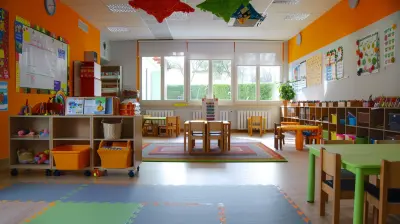Strategies to Boost Reading Comprehension in Young Learners
26 August 2025
Let’s be real — teaching kids to read is a little like teaching cats to do yoga. It’s not impossible, but you’re gonna need some clever tricks, a lot of patience, and probably a snack or two (for both of you). Helping young learners not only read but actually understand what they’re reading? That’s next-level sorcery.
If you’ve ever asked a child, “So, what was the story about?” and received a blank stare or an enthusiastic “A dog!”... when the story clearly featured a talking pineapple at a spelling bee, then buckle up — this guide is for you.
Let’s dive into some humorous (but seriously effective) strategies to boost reading comprehension in young learners. We’re talking creative, brain-boosting, giggle-inducing tactics that actually work.

Why Is Reading Comprehension Important Anyway?
Imagine reading a recipe and throwing in salt instead of sugar because you didn’t understand what the instructions meant. Now multiply that confusion across math word problems, history texts, science instructions — everything. Comprehension is like the brain’s Wi-Fi signal: without it, nothing downloads correctly.The earlier kids develop strong reading comprehension, the faster they become savvy, self-driven learners. Plus, it makes reading way more fun. Because, let’s face it, understanding the joke is much funnier than just reading the punchline.

Strategy #1: Read Aloud Like a Movie Star 🎬
Don’t just read... perform! Break out your inner voice actor. Use silly accents, dramatic pauses, and whisper like a spy during suspenseful scenes. This isn’t just for kicks — it actually helps!Reading aloud with expression boosts understanding because it slows the pace down and makes kids listen more closely. They’re not just hearing words — they’re absorbing tone, mood, and meaning.
Try This:
Let your child pick a character and give them a unique voice. You’ll end up with a whole cast of characters — from a British-speaking squirrel to a cowboy pizza slice — and your kid will start picking up context clues through tone alone.
Strategy #2: Talk Back to the Book (Yes, Really)
Active engagement is key. Instead of passively listening or reading, teach kids to talk to the book like it’s a nosy neighbor who’s always leaving out juicy details.Ask open-ended questions like:
- “Why do you think the frog did that?”
- “What do you think will happen next?”
- “Would you have made the same choice?”
It’s basically book gossip — and kids love gossip.
Tip:
Use the “Stop and Chat” approach. Pause every few pages to check in: summarize, guess what’s coming, or identify confusing parts.
Strategy #3: Visualize Like a Daydreamer 🎨
Reading isn’t just for the ears, folks — it’s for the mind's eye.Teach kids to create mental movies while they read. If the story says “The dragon soared above the cotton-candy clouds,” ask your child, “What does that look like in your head?” Suddenly, reading feels like watching a Pixar short film on their own mental big screen.
Activity Alert:
Have them draw a scene after every reading session. Stick figures encouraged. Heck, even purple unicorn-dragons are welcome.Strategy #4: Use the Magic of Graphic Organizers 🧠
Yes, the term “graphic organizer” sounds like something only a wizard teacher might use, but stick with me.These handy tools like story maps, Venn diagrams, and sequencing charts help kids organize their thoughts and make connections. It's like giving their brain a filing cabinet (with color-coded tabs!).
Examples:
- Story Map: Who? What happened? Where? When? Why? How?- Venn Diagram: Compare two characters or settings.
- Cause & Effect: What happened and why?
There are tons of free templates online, or you can just draw them out on your own. Bonus points for glitter pens.
Strategy #5: Make Vocabulary Fun (Not a Snoozefest)
You ever try teaching a 6-year-old what “melancholy” means? Let’s just say, they’ll either think it’s a fruit or a dance move.The key? Context and creativity!
When a new word pops up:
- Use it in a funny sentence.
- Act it out like charades.
- Make it rhyme with something ridiculous.
The more ridiculous, the more memorable. “Melancholy is like your ice cream falling on the sidewalk while a sad trumpet plays.”
Strategy #6: Let Them Be the Teacher 👩🏫
Flip the script. Let kids pretend they're the teacher. (Bonus: you get to put your feet up.)After reading a passage, ask them to “teach” you what happened. Their version might include a few imaginary unicorns or a marshmallow war, but it gives insight into what they understood.
When kids explain ideas in their own words, they process them more deeply. Also, they get a kick out of bossing you around. Win-win.
Strategy #7: Make Reading Personal
If your kid is into dinosaurs, don’t hand them a story about baking pies with Grandma (unless Grandma is a T-Rex). The more they care, the more they’ll comprehend. Curiosity fuels understanding.Whether it’s comics, joke books, animal facts, or futuristic robots who love cupcakes — read what interests them, not what just looks good on a bookshelf.
Pro Tip:
Find book series that match their favorite TV shows or hobbies. They’ll gobble them up like cookies on a cheat day.Strategy #8: Use Technology Without the Guilt
Yes, screen time can be your frenemy. But let’s use it for good, not evil.Apps and websites like Epic!, Reading Eggs, and Raz-Kids offer engaging, level-appropriate reading content with interactive features that subtly teach comprehension.
Many of these tools include quizzes, vocabulary games, and reading aloud options. They’re basically sneaky learning ninjas.
Just remember: balance is key. A little screen, a little paper book, a little acting like a pirate reading his treasure map. Mix it up!
Strategy #9: Re-Read and Re-Read Again
Let’s normalize re-reading — it’s not cheating, it’s learning!The first time, kids might just catch the plot. The second? They notice details. The third? They’re catching foreshadowing, emotions, and maybe even sarcasm (if they’re advanced little humans).
Think of it like watching your favorite movie three times. Didn’t catch that background llama the first time, did ya?
Strategy #10: Ask the Big Three
These three questions are like the Holy Trinity of Reading Comprehension:1. What happened?
2. Why does it matter?
3. How do you feel about it?
Simple? Yes.
Effective? Like peanut butter and jelly.
You’ll be amazed at how much a child can understand when they’re encouraged to connect emotionally and logically with the story.
Bonus Mini-Strategies (Because More is More):
- Create a reading fort – Because comprehension improves inside a blanket cave. That's just science.- Use props – Reading about pirates? Wear an eye patch.
- Make sound effects – Thunder? Roll some aluminum foil.
- Sing it out – Turn book lines into a song. You might regret it, but the kids won’t.
Final Thoughts: Reading Isn’t Just About Reading
Reading comprehension is about thinking, feeling, drawing connections, and asking “Hey, what’s really going on here?”It’s an essential life skill wrapped up in bedtime stories and class assignments. The earlier kids get the hang of it, the better off they’ll be in every subject — and in life.
So go on, get silly with it. Make reading fun. Add voices, build forts, and ask weird questions (like “Would this story still make sense if the main character was a chicken?”).
You’re not just helping young learners understand books — you’re teaching them to understand the world.
all images in this post were generated using AI tools
Category:
Reading ComprehensionAuthor:

Monica O`Neal
Discussion
rate this article
1 comments
Candace McFarlane
This article offers valuable strategies for enhancing reading comprehension in young learners. By incorporating diverse methods such as interactive reading sessions, visual aids, and critical questioning, educators can effectively support students’ understanding. Ensuring a balanced approach that considers individual learning styles can further enhance these efforts and foster a love for reading.
August 28, 2025 at 3:24 AM

Monica O`Neal
Thank you for your insightful comment! I’m glad you found the strategies valuable and agree on the importance of accommodating diverse learning styles to foster a love for reading.


